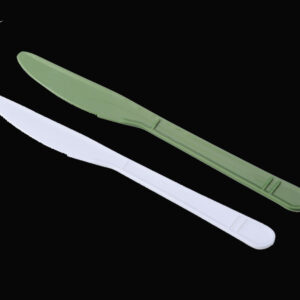Introduction
Disposable cornstarch tableware has become increasingly popular as a sustainable alternative to plastic and non-biodegradable materials. However, properly disposing of these eco-friendly products poses a significant challenge in regions with limited composting infrastructure. In this blog post, we will be looking at some practical strategies that can be used to ensure the correct removal of corn starch from tableware. We will delve into helpful tips, environmental considerations, and the cost-effectiveness of implementing these strategies. Whether you are new to the concept or already familiar with the topic, this post will provide valuable insights. It will focus on the sustainable management of cornstarch tableware in regions with limited composting infrastructure.

Why is proper disposal important?
Before we delve into the strategies, let’s briefly discuss why the proper disposal of cornstarch tableware is crucial. Unlike plastic products, which tend to persist in the environment for hundreds of years, cornstarch tableware is designed to be compostable. It breaks down into organic matter when disposed of correctly, offering an eco-friendly alternative to traditional single-use products.Proper disposal reduces the burden on landfill sites. It also ensures that valuable nutrients are returned to the soil, fostering a more sustainable ecosystem.
Strategy 1: Education and Awareness
Education and raising awareness are among the most effective ways to encourage proper disposal. We can drive behavior change by informing individuals, businesses, and communities about the benefits of composting and the appropriate disposal methods for cornstarch tableware. Organizations should conduct campaigns, distribute informative brochures, and leverage online platforms to educate the public about the importance of composting and the negative impacts of improper disposal. Empowering individuals with knowledge can significantly improve recycling habits and waste management practices.
Strategy 2: Composting Facilities and Infrastructure
Building and expanding composting facilities and infrastructure is essential for regions with limited composting options. These facilities enable the proper decomposition of cornstarch tableware, ensuring it returns to the soil as nutrient-rich compost. Local governments and waste management organizations should allocate resources to establish composting facilities or collaborate with private entities to develop composting infrastructure. This investment will not only alleviate the strain on landfills but also provide a sustainable solution for the disposal of cornstarch tableware.
Strategy 3: Home Composting
In regions with limited composting infrastructure, individuals can take matters into their own hands by implementing home composting systems. Household composting is a simple method. It’s an effective way to manage maize starch crockery and other organic wastes such as food and garden waste.c By turning kitchen waste into nutrient-rich compost, individuals can reduce their environmental footprint and contribute to the health of their gardens. Organizations and local governments should promote home composting through workshops, subsidies for composting bins, and educational materials.
Strategy 4: Industrial Composting Partnerships
Partnering with industrial composting facilities can be a viable solution for businesses and industries that generate large amounts of cornstarch tableware waste. Industrial composting facilities can handle significant quantities of organic waste, including cornstarch tableware. By setting up partnerships, companies can make sure that their waste is disposed of correctly and environmentally friendly. These facilities often have advanced composting technologies and systems, guaranteeing efficient decomposition and minimal environmental impact.
Strategy 5: Design for Disposal
Another approach to address the challenges of limited composting infrastructure is to focus on innovative design for disposal. Manufacturers can play a crucial role in developing cornstarch tableware. This tableware should be not only compostable but also compatible with existing waste management practices, such as anaerobic digestion or industrial composting. Manufacturers can overcome the limitations of limited composting infrastructure by designing products that align with the available disposal options in a given region and ensure proper disposal becomes more feasible.
Strategy 6: Collaboration with Waste Management Stakeholders
Collaboration between manufacturers, government bodies, and waste management companies is essential to tackle the challenges of limited composting infrastructure. Additionally, involving other stakeholders is also crucial in this effort. By working together, these entities can develop comprehensive waste management plans tailored to the specific needs of each region. This collaboration can involve financial investments in infrastructure, joint awareness campaigns, policy development, and the establishment of collection systems for cornstarch tableware. Open communication and shared responsibility among all parties are crucial to effective waste management practices.
Conclusion
In regions with limited composting infrastructure, the proper disposal of cornstarch tableware can be a challenging task. However, several strategies can be employed to overcome this challenge and ensure the sustainable management of these eco-friendly products. By conducting education and awareness campaigns, we can address limitations in waste management. Additionally, establishing composting facilities, home composting initiatives, and industrial composting partnerships can further contribute to this effort. Collaborative efforts among stakeholders will help foster a culture of responsible waste management. Only through collective efforts can we effectively reduce our environmental impact and pave the way for a more sustainable future.
If you are an industry buyer seeking cost-effective and environmentally friendly alternatives, investing in cornstarch tableware is commendable. Adopting the strategies outlined in this blog post ensures that cornstarch tableware is disposed of correctly, adding value to your sustainability goals and demonstrating your commitment to environmental stewardship. Remember, our actions today shape the world of tomorrow. Let’s join hands and make a positive difference.







